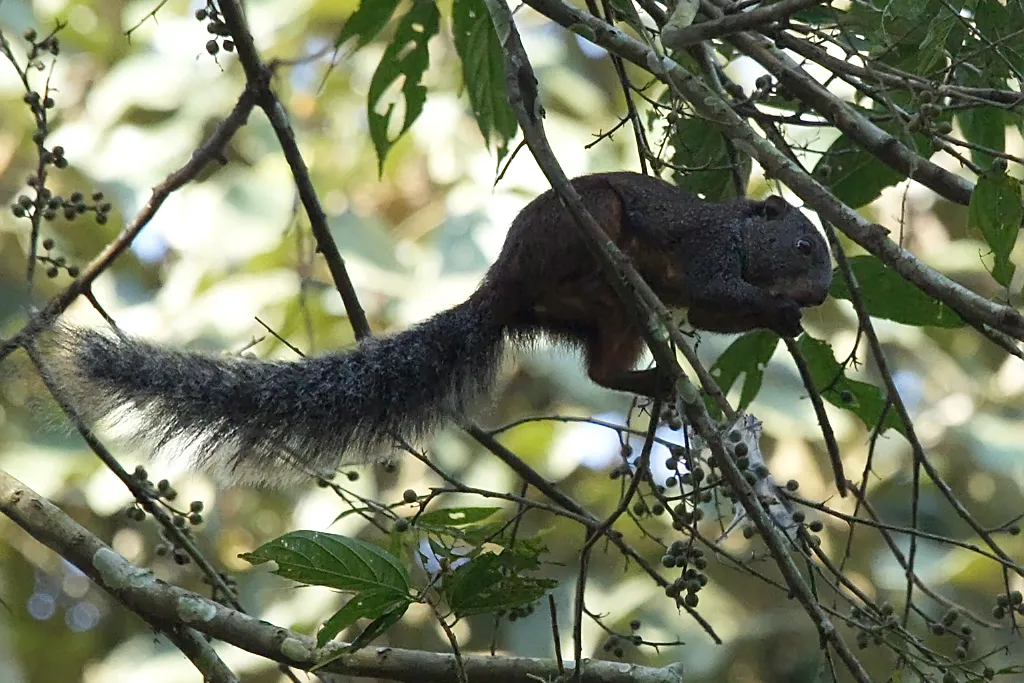Squirrels, Not Monkeys, May Be the Animal Source of Mpox, Researchers Suggest
Squirrels, Not Monkeys, May Be the Animal Source of Mpox, Researchers Suggest
A preliminary study traces an mpox outbreak in a group of Ivory Coast monkeys to the fire-footed squirrel, indicating the rodent may be a natural reservoir for the virus
Lillian Ali
- Staff Contributor
April 18, 2025 10:52 a.m.
Researchers suggest fire-footed rope squirrels might be a "reservoir species" for mpox, capable of harboring and spreading the virus without becoming sick. Here, one is photographed in Kibale National Park, Uganda.
David Cook via Flickr under CC BY-NC 2.0
In the Ivory Coast in West Africa, a baby sooty mangabey monkey fell ill. It developed red, pus-filled blisters all over its forehead, chest and legs. The rapidly spreading virus killed the monkey within three days. Over the next months, between January and April 2023, the virus infected about 25 others, or one-third of the group, killing four.
These monkeys had mpox, the infection caused by the monkeypox virus, a potentially deadly virus similar to the ones that cause smallpox and cowpox.
Mpox gets its name from the lab monkeys in which the disease was first observed in 1958, but scientists say the recent outbreak in Ivory Coast wildlife didn’t start with the baby monkey. Instead, it started with its mother. Or rather, its mother’s dinner: a fire-footed rope squirrel.
Researchers from the Helmholtz Institute in Germany have been observing this population of sooty mangabey monkeys in Ivory Coast’s Taï National Park since 2001. When the monkeys began getting sick in 2023, researchers had a unique opportunity to pinpoint the animal source of the outbreak by comparing their wealth of footage and biological data on the monkeys with virus samples they took from other species in the area. Their findings, which are currently awaiting peer review, were published as a preprint in Nature Portfolio this month.
Usually, scientists do not start studying disease outbreaks until weeks or months after they’re reported. However, since the monkey population was already being monitored, researchers were able to pinpoint an exact genetic match between the virus found in the monkeys and the virus found in the animal that likely caused it: the fire-footed rope squirrel, a rodent in West Central Africa.
“It’s unbelievable how well things fit together,” lead researcher Fabian Leendertz, a wildlife veterinarian at the Helmholtz Institute, tells Nature’s Jane Qiu.
Three sooty mangabey monkeys, of the same species that experienced an mpox outbreak in early 2023.
Justin Philbois via iNaturalist under CC0 1.0
The researchers went through hundreds of rodent and shrew carcasses to look for mpox infections and found one: the carcass of a squirrel that had died less than three months before the outbreak started. From video footage, they saw the monkeys eat rope squirrels, and fecal samples from the baby monkey’s mother, the first to contain DNA from the virus, revealed she had eaten a squirrel. The mother’s infection was asymptomatic, but the virus to spread throughout the population.
According to Nature, the findings offer the first evidence for squirrels transferring the virus to primates.
“Exposure to those squirrels is likely responsible for some human mpox outbreaks as well,” says Yap Boum, a biologist at the Africa Centers for Disease Control and Prevention who was not involved with the study, to Science’s Kai Kupferschmidt.
Researchers think the squirrel could be a reservoir host for the virus. A reservoir host is an organism in which a pathogen, like a virus, can live and reproduce, usually without getting the host sick. Bats, for example, are prolific reservoir hosts—they’ve been found to harbor Ebola, rabies and coronavirus.
However, the complete role of these squirrels in mpox transmission isn’t fully understood. Délia Doreen Djuicy, a disease ecologist at the Pasteur Center of Cameroon, tells Nature that the squirrels could either be a reservoir host or merely a susceptible species in the chain of inter-species infection. So far, she adds, researchers don’t have enough evidence to show that the rope squirrels can carry and shed the virus without becoming sick.
Leandre Murhula Masirika, who helped discover a new mpox strain last year but was not involved in the new research, tells Maeve Cullinan of the Telegraph that rope squirrels are “the most probable species to be the reservoir of the disease.”
“The rope squirrels that I have tested always have antibodies for mpox,” he adds. “Historically, nearly all the outbreaks of clade 1 mpox in Africa have been in areas where people commonly eat rope squirrels.”
Get the latest stories in your inbox every weekday.


